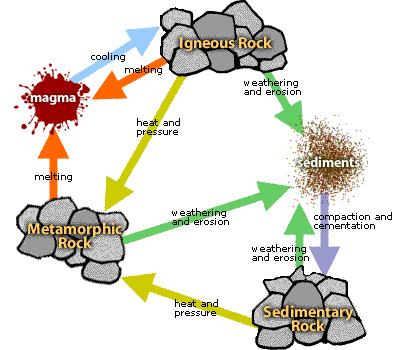Today we reviewed for the quiz both as a group and independently. We discussed all the topics of the first, second, and third sections as a class. Then we studied independently or in small groups. I studied independently first, but then I joined a small group using Kahoot. We did several of its quizzes talking about Rock Identification and the characteristics of the three types of rocks. Kahoot ranks you against you friends, and I did quite well so I think I will do well on the quiz tomorrow. I cannot wait to see how it affects my overall grade.
Tuesday or December 8, 2015 C.E.:
Today we took the quiz on the first three sections of Unit 5. It contained a variety of information like what Felsic and Mafic rocks are, what they look like, and their density. It also had questions about Igneous intrusions such as dikes, sills, lacoliths, and stocks. There were also questions about the texture of different types of rocks based on their origins and questions about Metamorphism and the construction of the types of Sedimentary rock. I think I knew all the topics and I will get a good grade. It will definitely help my overall grade.
Wednesday or December 9, 2015 C.E.:
Today we reviewed the quiz and I got a 99%. This sure is good news for my grade! After reviewing it, we took notes to start the rest of the Unit. We learned about Section 4, the rock cycle. We learned how each rock becomes the other and why. We also talked about how Plate Tectonics helps drive the rock cycle though two processes, Subduction and Uplift. Subduction helps rock melt and Uplift exposes them to Weathering and erosion. We also drew a diagram of the rock cycle similar to the one below.
 |
| The Rock Cycle |
Thursday or December 10, 2015 C.E.:
Today I started the Sedimentary Rock Lab. I had to identify seven rocks, Rock Gypsum, Limestone, Tufa, Conglomerate, Dolostone, Shale, and Sandstone. Dolostone was the hardest to classify. Rock Gypsum and Limestone were Chemical Sedimentary rocks. Limestone was also an Organic Sedimentary rock. The other rocks were all Clastic Sedimentary rocks. I also did reflection questions concerning Evaporites which are Chemical and Sedimentary "Veneers" which are coverings of Sedimentary rocks. I completed the lab in one day and I hope I will get a good grade.
Friday or December 11, 2015 C.E.:
Today we did our Rock Identification Practical. We spent the beginning of class studying for it, so not everyone was in the testing area at once. We had to identify 15 rocks. There were 13 mandatory rocks and 2 bonus rocks. The 13 mandatory rocks were quite easy. The 2 bonus rocks were not so easily recognized. They were Rhyolite and Tufa. I got Rhyolite, but got Tufa mixed up with an Igneous rock called Tuff. This is ok though because my final score with the bonus was 102% which is awesome.
Summary: This week was great. I did very well on two major assessments and was very efficient. However, I can still do my blog faster and more efficiently and I will do so in the next blog post.






